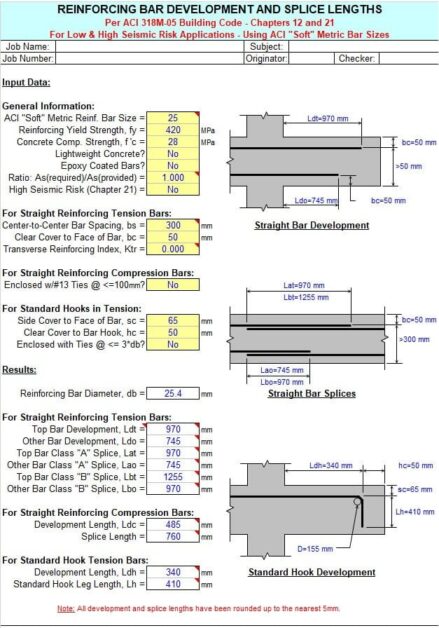
Skip to end of metadataGo to start of metadata
In ETABS, shell or area element has two types of stiffnesses i.e. inplane stiffness refers as f11, f22 and f12 and out-of-plane stiffness refers as m11, m22 and m12. Refer to the below Figure which shows the direction of local axes and their corresponding stiffnesses:
ACI – 318; ADAPT-BUILDER 1. OVERVIEW Punching shear calculation applies to column-supported slabs, classified as two-way structural systems. This writing (i) defines the different conditions for punching shear calculation, (ii) presents the relationships used for code check of each condition using ACI-318, (iii) presents a numerical. If the reinforcement spacing is set equal to the limiting values of Eqs. (11) and (12) in ACI 318-05, then the maximum flexural crack width can be controlled within the range from 0.40 to 0.50 mm. ACI 318-14 also uses the design equations that were recommended by ACI 318-05 for flexural crack width control. Crack width calculation methods in large concrete structures” carried out by Reignard Tan. The seminar is to be hosted by NTNU and Multiconsult ASA in a joint collaboration. The main goal is to increase the understanding and knowledge of crack width calculations for relatively large concrete structures in the Serviceability Limit State. A: The ACI 318-14 Commentary to Section 6.6.3.1.1 states: “If the factored moments and shears from an analysis based on the moment of inertia of a wall, taken equal to 0.70Ig, indicate that the wall will crack in flexure, based on the modulus of rupture, the analysis should be repeated with I = 0.35Ig in those stories where cracking is.
For shear wall (both piers and spandrels), the flexural and axial behavior is modified by either f11 or f22 depending on the orientation of the local axis and the shear behavior is controlled by f12. In column and code terms f11 or f22 would correspond to modifications of EI or EA and f12 would correspond to modifications to GAshear. The code recommendations in Section 10.10 of ACI 318 code are related to slenderness effects where flexural deformations govern so they have recommended modifying EI (corresponding to f11 or f22 for shear walls). There is no recommendation about reducing the GAshear. You should, however, note that some of our users use modifiers for f12 also, where they expect deterioration of shear stiffness and want to be realistic in their modeling.
The above discussion applies assuming the local axes 1 and 2 of the shear wall area object are either vertical or horizontal. This is under user control. When drawing in ETABS the default is to have the 1 axis horizontal and the 2 axis vertical. This means that the flexural modifier for EI should be applied to f22 for wall piers and to f11 for spandrels. If you apply the modifier to both f11 and f22 it hardly affects the results.
For slabs where bending is always in the out-of-plane direction, modifiers m11, m22 and m12 are required to model cracking behavior.
Summary
Assuming beams and columns are modeled as frame then the stiffness modifier table is as follows:
ACI ETABS
Beams........................................0.35*Ig I22 = I33 = 0.35
Columns....................................0.70*Ig I22 = I33 = 0.70
Walls-Uncracked.................0.70*Ig modeled as shell – f11, f22 = 0.70

Walls-Cracked......................0.35*Ig similar to Walls-Uncracked (with modifiers of 0.35)
NOTE:
Walls are generally not designed for out-of-plane bending to avoid excessive longitudinal reinforcement. In this case, use a small modifier say 0.1 for m11, m22 and m12 so numerical instabilities could be avoided. However, use m11, m22, m12 = 0.70 (or 0.35) when considering the out-of-plane bending in wall.
Crack Width Calculation As Per Aci 318 14 Online
Flat Plates & Flat Slabs....0.25*Ig modeled as membrane – f11, f22, f12 = 0.25 / modeled as shell – f11, f22, f12, m11, m22, m12 = 0.25 (for both cases fxx is not important if rigid diaphragm is assigned)

JavaScript must be enabled in order to use this site.
Please enable JavaScript in your browser and refresh the page.
When beam design is done per ACI 318, STAAD will report the moment of inertia of the cracked section at the location where the design is performed. The cracked section properties are calculated in accordance with the equations shown below.
Rectangular Sections
Gross section (A) and cracked transform section (B) for rectangular shapes
Without compression steel
n = EI/Ec
Tee Shaped Sections
Gross and cracked transform sections for tee shapes without compression steel
Without compression steel
See D1.F.4.5 Beam Design Output for an example of output including the calculated cracked moment of inertia.
Crack Width Calculation As Per Aci 318 14 Pdf
